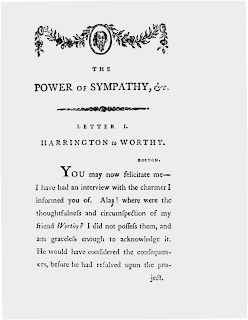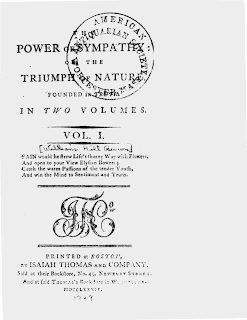Mike Hicks
AML 4101
Dr. Lisa Logan
20 October 2008
Forcey, Blythe. “Charlotte Temple and the End of Epistolarity.” American Literature: A
Journal of Literary History, Criticism, and Bibliography 63 (1991): 225-41.
Among fellow seduction novels such as The Power of Sympathy and The Coquette, Susanna Rowson’s bestseller Charlotte Temple appears to be an anomaly: a tale of seduction not written in the then-popular epistolary form. However, as Blythe Forcey explains in her article “Charlotte Temple and the End of Epistolarity,” written correspondence remains a fundamental aspect of the text and the novel illuminates both the reasons for the form’s popularity and its imminent demise.
Forcey begins by providing her main thesis: that the epistolary could not survive because “…it fell victim to the same forces of seduction and betrayal that its heroines were unable to avoid.” Thus, she contends, a traditional plot and a unifying narrative voice effectively rendered the epistolary obsolete. As the birth of the American novel cannot be separated from the birth of the nation itself, Forcey describes in detail the burgeoning population of the New World, contending that the literary conventions of the
At this point in the article Forcey begins to analyze the plot of Charlotte Temple and establishes the author’s narrative interventions as almost an act of censorship, providing examples of the narrator refraining from displaying the text of a letter and making self-conscious efforts to realign the interpretations of the reader. Here (specifically regarding the omission of a letter) Forcey establishes another major point: that the inclusion of said letters causes an unintended identification with the villain. Quoting from Wayne Booth, Forcey says that “in any novel, ‘a prolonged intimate view of a character works against our capacity for judgment.’” Thus, the narration in Charlotte Temple serves three purposes according to Forcey: intervention to protect the character of
The totality of analysis that Forcey provides leads to the view that the narration in Charlotte Temple provides an “authoritative, unifying voice which gives structure and guidance to the reader.” This is something, significantly, that the epistolary novel lacks. Forcey points out that once
Finally, Forcey writes about the many French and multilingual characters in the novel, stating that those who wanted to survive in the evolving and increasingly foreign-influenced America would be forced to create “new and imaginative ways to communicate effectively with each other and the world” for which the narrated novel could serve this purpose. Forcey ends by stating that the American audience continued to favor the narrated novel after Charlotte Temple and that this new narrative style marked the beginning of a powerful new force in American literature.
This article works primarily due to the historical and sociological contexts Forcey places it in. She uses the novel Charlotte Temple as a metaphor for the death of the epistolary novel—noting several occasions within the piece where characters are denied access to letters and incapable of writing them themselves. She utilizes the words of several scholars, yet fails to provide more insight outside of the novel itself. More historical references to past epistolary novels could have given the article greater context. Her notion that the epistolary novel is seemingly incapable of providing a singular, unified viewpoint is interesting and perhaps accurate, and her opinion that modern readers interpret the epistolary with their own preconceived notions is certainly not without merit. Although this article does not address The Power of Sympathy, it provides important context and background to the form of the epistolary novel, as well as insights into its demise, which is something I am interested in addressing for a significant portion of my project. I found Forcey’s argument to be successful, by and large, having provided me with important insights regarding the form of the novel I’m currently researching. I’d recommend this article for students either studying the epistolary form or the seduction novel itself, as it provides historical context, textual interpretation, and educated suppositions to provide insight into this rarely-used style.







